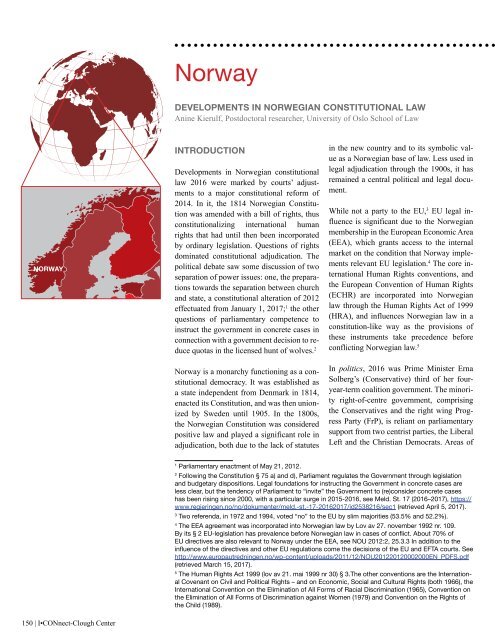2016 Global Review of Constitutional Law
I-CONnect–Clough Center collaboration.
I-CONnect–Clough Center collaboration.
You also want an ePaper? Increase the reach of your titles
YUMPU automatically turns print PDFs into web optimized ePapers that Google loves.
Norway<br />
DEVELOPMENTS IN NORWEGIAN CONSTITUTIONAL LAW<br />
Anine Kierulf, Postdoctoral researcher, University <strong>of</strong> Oslo School <strong>of</strong> <strong>Law</strong><br />
NORWAY<br />
INTRODUCTION<br />
Developments in Norwegian constitutional<br />
law <strong>2016</strong> were marked by courts’ adjustments<br />
to a major constitutional reform <strong>of</strong><br />
2014. In it, the 1814 Norwegian Constitution<br />
was amended with a bill <strong>of</strong> rights, thus<br />
constitutionalizing international human<br />
rights that had until then been incorporated<br />
by ordinary legislation. Questions <strong>of</strong> rights<br />
dominated constitutional adjudication. The<br />
political debate saw some discussion <strong>of</strong> two<br />
separation <strong>of</strong> power issues: one, the preparations<br />
towards the separation between church<br />
and state, a constitutional alteration <strong>of</strong> 2012<br />
effectuated from January 1, 2017; 1 the other<br />
questions <strong>of</strong> parliamentary competence to<br />
instruct the government in concrete cases in<br />
connection with a government decision to reduce<br />
quotas in the licensed hunt <strong>of</strong> wolves. 2<br />
Norway is a monarchy functioning as a constitutional<br />
democracy. It was established as<br />
a state independent from Denmark in 1814,<br />
enacted its Constitution, and was then unionized<br />
by Sweden until 1905. In the 1800s,<br />
the Norwegian Constitution was considered<br />
positive law and played a significant role in<br />
adjudication, both due to the lack <strong>of</strong> statutes<br />
in the new country and to its symbolic value<br />
as a Norwegian base <strong>of</strong> law. Less used in<br />
legal adjudication through the 1900s, it has<br />
remained a central political and legal document.<br />
While not a party to the EU, 3 EU legal influence<br />
is significant due to the Norwegian<br />
membership in the European Economic Area<br />
(EEA), which grants access to the internal<br />
market on the condition that Norway implements<br />
relevant EU legislation. 4 The core international<br />
Human Rights conventions, and<br />
the European Convention <strong>of</strong> Human Rights<br />
(ECHR) are incorporated into Norwegian<br />
law through the Human Rights Act <strong>of</strong> 1999<br />
(HRA), and influences Norwegian law in a<br />
constitution-like way as the provisions <strong>of</strong><br />
these instruments take precedence before<br />
conflicting Norwegian law. 5<br />
In politics, <strong>2016</strong> was Prime Minister Erna<br />
Solberg’s (Conservative) third <strong>of</strong> her fouryear-term<br />
coalition government. The minority<br />
right-<strong>of</strong>-centre government, comprising<br />
the Conservatives and the right wing Progress<br />
Party (FrP), is reliant on parliamentary<br />
support from two centrist parties, the Liberal<br />
Left and the Christian Democrats. Areas <strong>of</strong><br />
1<br />
Parliamentary enactment <strong>of</strong> May 21, 2012.<br />
2<br />
Following the Constitution § 75 a) and d), Parliament regulates the Government through legislation<br />
and budgetary dispositions. Legal foundations for instructing the Government in concrete cases are<br />
less clear, but the tendency <strong>of</strong> Parliament to “invite” the Government to (re)consider concrete cases<br />
has been rising since 2000, with a particular surge in 2015-<strong>2016</strong>, see Meld. St. 17 (<strong>2016</strong>–2017), https://<br />
www.regjeringen.no/no/dokumenter/meld.-st.-17-<strong>2016</strong>2017/id2538216/sec1 (retrieved April 5, 2017).<br />
3<br />
Two referenda, in 1972 and 1994, voted “no” to the EU by slim majorities (53.5% and 52.2%).<br />
4<br />
The EEA agreement was incorporated into Norwegian law by Lov av 27. november 1992 nr. 109.<br />
By its § 2 EU-legislation has prevalence before Norwegian law in cases <strong>of</strong> conflict. About 70% <strong>of</strong><br />
EU directives are also relevant to Norway under the EEA, see NOU 2012:2, 25.3.3 In addition to the<br />
influence <strong>of</strong> the directives and other EU regulations come the decisions <strong>of</strong> the EU and EFTA courts. See<br />
http://www.europautredningen.no/wp-content/uploads/2011/12/NOU201220120002000EN_PDFS.pdf<br />
(retrieved March 15, 2017).<br />
5<br />
The Human Rights Act 1999 (lov av 21. mai 1999 nr 30) § 3.The other conventions are the International<br />
Covenant on Civil and Political Rights – and on Economic, Social and Cultural Rights (both 1966), the<br />
International Convention on the Elimination <strong>of</strong> All Forms <strong>of</strong> Racial Discrimination (1965), Convention on<br />
the Elimination <strong>of</strong> All Forms <strong>of</strong> Discrimination against Women (1979) and Convention on the Rights <strong>of</strong><br />
the Child (1989).<br />
150 | I•CONnect-Clough Center


